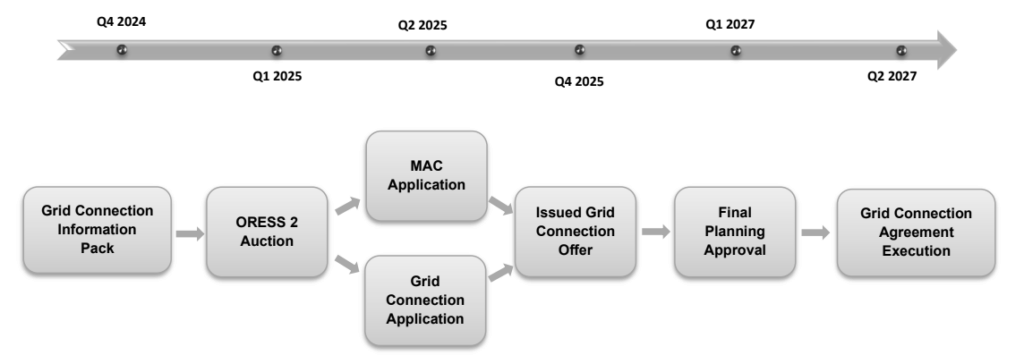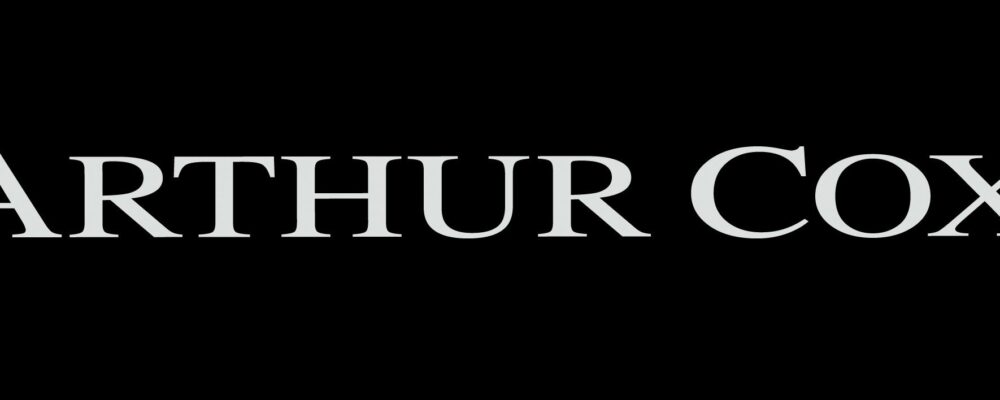In October 2024, some key building blocks for Phase 2 have been put in place. They include Government approval of the South-Coast Designated Maritime Area Plan and a Decision on Grid Connection Policy.
South-Coast Designated Maritime Area Plan (“SC-DMAP”)
The Oireachtas has approved the SC-DMAP, which is available at the link here.
The SC-DMAP identifies four proposed maritime areas off the South Coast within which fixed offshore wind farms may be located. Area A, Tonn Nua, is the site to be developed by the successful bidder in the next public subsidy auction, ORESS 2.1, expected to begin in Q1 2025. Draft terms and conditions for ORESS 2.1 are available here.

Grid Connection Policy
A decision of the Commission for Regulation of Utilities (“CRU”) on grid connection policy applies only to Phase 2 projects supported by the Offshore Renewable Electricity Support Scheme (“ORESS”). It is available at the following link: Offshore Grid Connection Pathway. The approach for non-ORESS projects is to be developed separately.
The connection pathway will begin before each ORESS auction. It is illustrated by CRU for ORESS 2.1 as follows:

These are the key steps:
- Grid Connection Information (“GCI”) Pack: EirGrid will publish a GCI pack on feasible options for grid access for each auction site, at least 90 calendar days before the start of an auction. The GCI pack is intended to detail the connection methodology and cost of connecting projects to the transmission system. Minimum information it must contain has been specified in the CRU’s decision, and information may be added as a result of engagement, described below.
- Engagement: EirGrid will publish an engagement plan within 15 calendar days, and hold industry workshops no later than 30 calendar days, following the establishment of the DMAP and publication of the ORESS terms and conditions.
- Application for Full Connection Offer (“FCO”): A project should submit its FCO application within three months of receipt of the ORESS Notice of Award of Phase 2.The purpose of this deadline is to facilitate the State in meeting obligations for the permit-granting procedure under the Recast Renewable Energy Directive (“RED III“). Maximum Export Capacity (“MEC”) in the application must be equal to or lower than the MW limit in the GCI pack. The application becomes invalid if the Maritime Area Consent (“MAC”) application is unsuccessful or the ORESS Letter of Offer is rescinded.
- Full Connection Offer: EirGrid will issue a FCO within a target of 90 business days from the application. The FCO can only be issued if the project has a valid MAC and ORESS Letter of Offer. The FCO will be valid for three months after conclusion of the planning consent process (described as issue of the decision on the planning consent application and outcome of any judicial review proceedings taken in relation to that decision).
- Execution of Full Connection Offer: The FCO can only be executed if the project has an ORESS Letter of Offer, MAC, and Final Planning Consent. If those become invalid, the Connection Agreement becomes invalid.
- Firm Access Treatment: When ORESS terms and conditions are published, capacity to be auctioned will be incorporated in EirGrid’s Firm Access Allocation Runs (as outlined under the methodology, here, and detailed methodology, here). Successful Phase 2 ORESS projects will be provided with a Firm Access Date and Quantity in the FCO.
The CRU states it has considered the permitting timeframes set out in RED III. RED IIIrequires Member States to ensure that the permit-granting procedure shall not exceed three years for offshore renewable energy projects located outside renewables acceleration areas (such areas have not yet been identified in Ireland.) This can be extended by six months where duly justified on the grounds of extraordinary circumstances, in which case the Member State must inform the project developer clearly of the extraordinary circumstances that justify such an extension.
Grid Connection Charging Policy
The CRU has published a decision on grid connection charging policy for ORESS Phase 2 offshore wind projects. It is available at the following link here.
The costs of offshore transmission assets developed by EirGrid will be charged to offshore generators through an Offshore Grid Charge (“OG-TUoS”). OG-TUoS will be fixed for a period of 30 years, in advance of each ORESS auction, based on EirGrid’s estimated cost of the connection assets. It will include a fixed rate of return and will not be subject to inflation indexation. Any difference between the fixed OG-TUoS and the final outturn cost of the connection asset will be charged to the customer base through Demand Transmission Use of System tariffs.
This approach means that the cost of building grid assets will largely be bid into ORESS auctions and appear to end users as a cost of supporting renewable energy generation, as distinct from the cost of building enabling grid infrastructure. Developers will wish to be alert to the risk, if connection is delayed, of the subsidy period over which they can recover costs, being shortened.
The CRU states that there is a challenge around the development of EirGrid’s initial cost estimate for the ORESS 2.1 auction, given the timing of the auction. It expects that the estimate will be based on the capex cost estimate that EirGrid will use in its PR6 business plans.
Charging policy for routes to market other than ORESS is to be considered further.
Next Steps
EirGrid is to implement the CRU’s Decision, include the proposed capacity from the Tonn Nua in its next Firm Access Allocation Run, and publish the GCI pack.
EirGrid is also to submit a detailed cost estimate for the Tonn Nua grid connection assets to the CRU by 31 October 2024, and to publish charging information in advance of the ORESS 2.1 auction.
The post Offshore Renewable Energy (Phase 2): Area Designation and Grid Connection Path appeared first on Arthur Cox LLP.
“Arthur Cox LLP is one of Ireland’s leading law firms. We are an “all-island” firm with offices in London, New York, and San Francisco. Our practice encompasses all aspects of corporate and business law.”
Please visit the firm link to site



